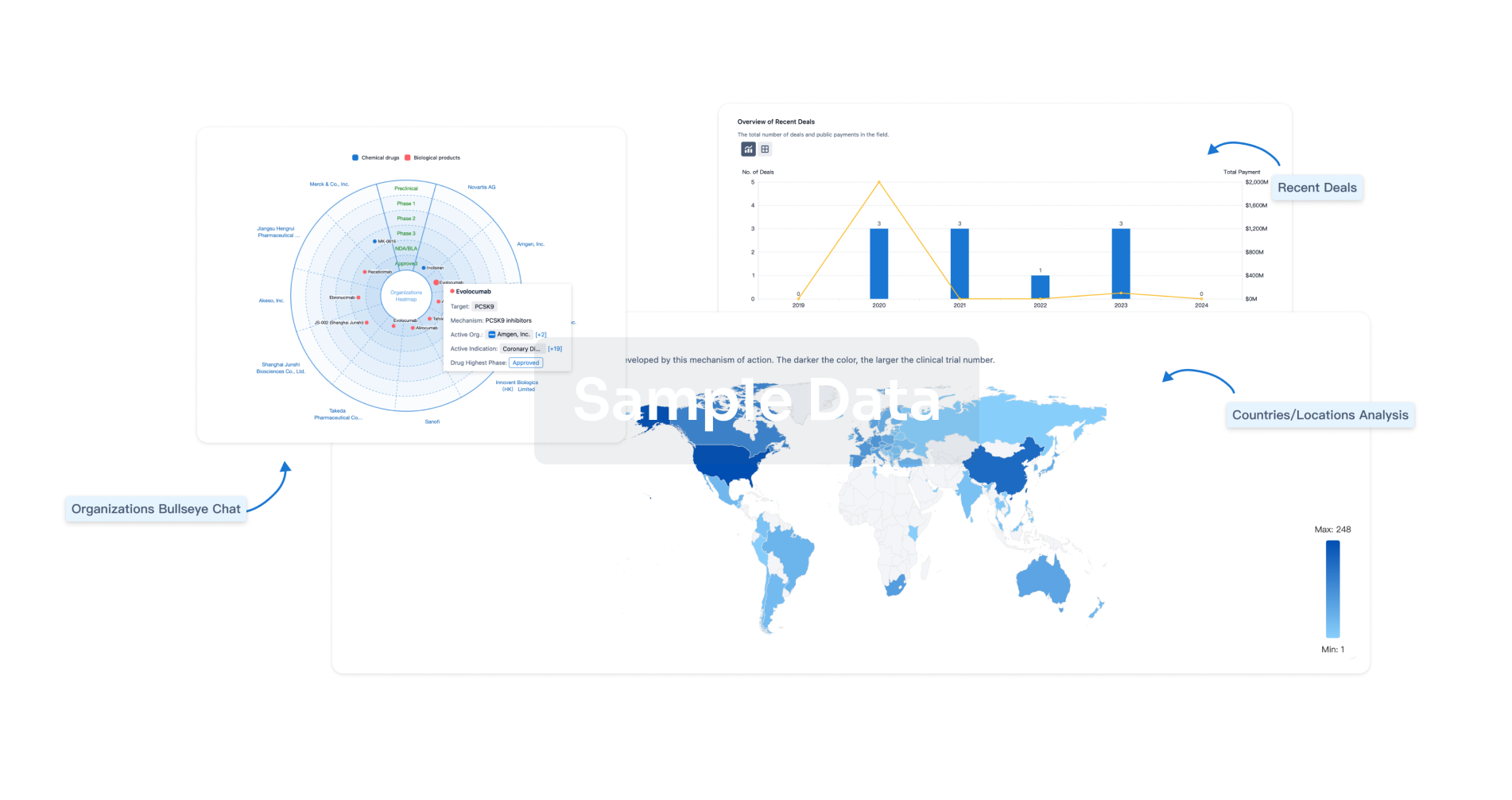Request Demo
Last update 08 May 2025
ATM
Last update 08 May 2025
Basic Info
Synonyms A-T mutated, ATA, Ataxia telangiectasia mutated + [11] |
Introduction Serine/threonine protein kinase which activates checkpoint signaling upon double strand breaks (DSBs), apoptosis and genotoxic stresses such as ionizing ultraviolet A light (UVA), thereby acting as a DNA damage sensor (PubMed:10550055, PubMed:10839545, PubMed:10910365, PubMed:12556884, PubMed:14871926, PubMed:15064416, PubMed:15448695, PubMed:15456891, PubMed:15790808, PubMed:15916964, PubMed:17923702, PubMed:21757780, PubMed:24534091, PubMed:35076389, PubMed:9733514). Recognizes the substrate consensus sequence [ST]-Q (PubMed:10550055, PubMed:10839545, PubMed:10910365, PubMed:12556884, PubMed:14871926, PubMed:15448695, PubMed:15456891, PubMed:15916964, PubMed:17923702, PubMed:24534091, PubMed:9733514). Phosphorylates 'Ser-139' of histone variant H2AX at double strand breaks (DSBs), thereby regulating DNA damage response mechanism (By similarity). Also plays a role in pre-B cell allelic exclusion, a process leading to expression of a single immunoglobulin heavy chain allele to enforce clonality and monospecific recognition by the B-cell antigen receptor (BCR) expressed on individual B-lymphocytes. After the introduction of DNA breaks by the RAG complex on one immunoglobulin allele, acts by mediating a repositioning of the second allele to pericentromeric heterochromatin, preventing accessibility to the RAG complex and recombination of the second allele. Also involved in signal transduction and cell cycle control. May function as a tumor suppressor. Necessary for activation of ABL1 and SAPK. Phosphorylates DYRK2, CHEK2, p53/TP53, FBXW7, FANCD2, NFKBIA, BRCA1, CREBBP/CBP, RBBP8/CTIP, MRE11, nibrin (NBN), RAD50, RAD17, PELI1, TERF1, UFL1, RAD9, UBQLN4 and DCLRE1C (PubMed:10550055, PubMed:10766245, PubMed:10802669, PubMed:10839545, PubMed:10910365, PubMed:10973490, PubMed:11375976, PubMed:12086603, PubMed:15456891, PubMed:19965871, PubMed:21757780, PubMed:24534091, PubMed:26240375, PubMed:26774286, PubMed:30612738, PubMed:30886146, PubMed:30952868, PubMed:38128537, PubMed:9733515, PubMed:9843217). May play a role in vesicle and/or protein transport. Could play a role in T-cell development, gonad and neurological function. Plays a role in replication-dependent histone mRNA degradation. Binds DNA ends. Phosphorylation of DYRK2 in nucleus in response to genotoxic stress prevents its MDM2-mediated ubiquitination and subsequent proteasome degradation (PubMed:19965871). Phosphorylates ATF2 which stimulates its function in DNA damage response (PubMed:15916964). Phosphorylates ERCC6 which is essential for its chromatin remodeling activity at DNA double-strand breaks (PubMed:29203878). Phosphorylates TTC5/STRAP at 'Ser-203' in the cytoplasm in response to DNA damage, which promotes TTC5/STRAP nuclear localization (PubMed:15448695). Also involved in pexophagy by mediating phosphorylation of PEX5: translocated to peroxisomes in response to reactive oxygen species (ROS), and catalyzes phosphorylation of PEX5, promoting PEX5 ubiquitination and induction of pexophagy (PubMed:26344566). |
Related
29
Drugs associated with ATMTarget |
Mechanism ATM inhibitors |
Originator Org. |
Active Indication |
Inactive Indication |
Drug Highest PhasePhase 2 |
First Approval Ctry. / Loc.- |
First Approval Date20 Jan 1800 |
Target |
Mechanism ATM inhibitors |
Active Org. |
Active Indication |
Inactive Indication- |
Drug Highest PhasePhase 1/2 |
First Approval Ctry. / Loc.- |
First Approval Date20 Jan 1800 |
Target |
Mechanism ATM inhibitors |
Originator Org. |
Active Indication |
Inactive Indication- |
Drug Highest PhasePhase 1 |
First Approval Ctry. / Loc.- |
First Approval Date20 Jan 1800 |
22
Clinical Trials associated with ATMNCT06894979
A Phase I Study to Assess the Safety, Tolerability, Pharmacokinetics, and Preliminary Efficacy of AZD1390 (NSC# 852149) When Combined With Focal Radiation in Pediatric Patients With High Grade Glioma
This phase I clinical trial studies the side effects and best dose of AZD1390 and to see how well it works when given together with radiation therapy for the treatment of pediatric patients with high grade glioma, diffuse midline glioma or diffuse intrinsic pontine glioma. AZD1390 is in a class of medications called kinase inhibitors. It works by blocking the signals that cause cancer cells to multiply. This helps to stop the spread of cancer cells. Radiation therapy uses high energy x-rays, particles, or radioactive seeds to kill cancer cells and shrink tumors. Giving AZD1390 with radiation may be safe, tolerable, and/or effective in treating pediatric patients with high grade glioma, diffuse midline glioma or diffuse intrinsic pontine glioma.
Start Date07 May 2025 |
Sponsor / Collaborator |
NCT06829173
A Phase 0/I Study to Assess the Safety and Tolerability of XRD-0394 in Combination With Radiation Therapy in Patients With High Grade Gliomas
This is an open-label, dose-finding study of XRD-0394 in subjects with newly diagnosed and recurrent high grade gliomas receiving radiation therapy, with and without concurrent temozolomide based on O6-Methylguanine-DNA methyltransferase (MGMT) status for patients with newly diagnosed high grade gliomas.
Start Date01 Apr 2025 |
Sponsor / Collaborator |
NCT06775236
A Phase 1b/2 Clinical Study to Evaluate the Safety and Efficacy of SYS6010 as a Monotherapy or in Combination With SYH2051 Compared to Investigator's Choice Chemotherapy in Patients With EGFR-Expressing Advanced Unresectable or Metastatic Solid Tumors, Including But Not Limited to Breast Cancer
The study consists of two phases. Phase 1b and Phase 2. Phase 1b aims to evaluate the safety, tolerability, and preliminary efficacy of SYS6010 as a monotherapy and in combination with SYH2051, and to determine the recommended Phase 2 dose (RP2D) for subsequent Phase 2 studies. Phase 2 aims to assess the efficacy and safety of SYS6010 monotherapy or in combination with SYH2051 compared to investigator-selected chemotherapy in patients with EGFR-expressing, unresectable locally advanced or metastatic advanced breast cancer.
Start Date20 Mar 2025 |
Sponsor / Collaborator |
100 Clinical Results associated with ATM
Login to view more data
100 Translational Medicine associated with ATM
Login to view more data
0 Patents (Medical) associated with ATM
Login to view more data
13,965
Literatures (Medical) associated with ATM31 Dec 2025·Journal of Enzyme Inhibition and Medicinal Chemistry
Medicinal chemistry breakthroughs on ATM, ATR, and DNA-PK inhibitors as prospective cancer therapeutics
Review
Author: Singh, Gurpreet ; Mishra, Anshul ; Bhardwaj, Monika ; Pan, Chun Hsu ; Nepali, Kunal ; Sharma, Ram ; Vanjani, Sakshi ; Indira Harahap, Larasati Vanya
31 Dec 2025·Future Science OA
Germline variants analysis of Chinese breast cancer patients reveals numerous alterations in homologous recombination genes
Article
Author: Jiang, Zhaoyun ; Zhang, Juan ; Li, Mengjian ; Yang, Beibei ; Qi, Liqiang ; Xu, Bing ; Sun, Bo ; Lu, Su ; Wu, Qixi
01 Dec 2025·Molecular Biology Reports
Beyond the BRCA1/2 genes in ovarian cancer: the role of germline pathogenic variants in the ATM gene
Article
Author: Maneri, Giulia ; Chiavassa, Antonella ; Guadagnolo, Daniele ; Minucci, Angelo ; Grotta, Simona ; Grammatico, Paola ; Piane, Maria ; De Marchis, Laura ; Pizzuti, Antonio ; Salvatori, Francesca ; Santini, Daniele ; Khaleghi Hashemian, Nader ; Gentile, Gabriella
102
News (Medical) associated with ATM29 Apr 2025
Artios Pharma, a startup developing drugs that weaken a tumor’s ability to maintain its DNA, announced positive results in a subset of patients with advanced cancer. It’s the first big data reveal for the Cambridge, UK-based startup, which has been relatively quiet since 2021, when it struck a drug discovery partnership with Novartis and raised $153 million in Series C financing.
The company’s drug, called ART0380, inhibits a DNA repair enzyme called ATR. When administered with a low dose of the chemotherapy irinotecan, the drug shrank tumors in 37% of patients whose cancer was considered “deficient” in another DNA damage response protein dubbed ATM, according to data from a Phase 1/2 study.
In patients whose tumors lacked the ATM protein entirely, the response rate was 50%, with a median duration of response of 5.7 months so far. The response rate was 22% in patients with low levels of ATM.
Patients with the ATM protein, however, did not respond to the therapy. “All those patients unfortunately progress quickly and unfortunately die very quickly,” Artios Chief Medical Officer Ian Smith told
Endpoints News
in an interview.
The new data, presented Tuesday at the American Association for Cancer Research meeting, comes from 58 patients with advanced-stage and metastatic solid tumors who were treated at the dose the company plans to use in a Phase 2 study.
Artios CEO Niall Martin told Endpoints that the company has funds “through 2026.” He said the startup is looking to raise another round of private funding to test its ATR inhibitor in pancreatic and colorectal cancers before pursuing bigger and broader tissue-agnostic studies.
Martin said the company’s partnership with Novartis, which wasn’t focused on its ATR inhibitor, identified several targets that could potentially be paired with Novartis’
radioligand therapies, including its prostate cancer drug Pluvicto, and discussions are underway on next steps. Artios had struck a
partnership
with Merck KGaA in 2020 to search for drugs that target other DNA repair proteins, but Martin told Endpoints that partnership has ended.
Artios was founded in 2016 to discover a new wave of drugs that target complex networks of proteins dedicated to the faithful replication and preservation of our genomes. While cancer can survive, and even thrive, with some DNA repair enzymes missing, too many missing pieces can cause the cancer to self-destruct.
A class of drugs called PARP inhibitors exploit this vulnerability by blocking the eponymous DNA repair protein in tumors that have mutations in genes called BRCA1 and BRCA2, which are also important for DNA repair. Several companies have been searching for the next combination of targets that can deliver a similar double whammy to tumors, but progress has been slow.
“The field hasn’t really evolved much since PARP inhibitors,” Martin said. “So we’ve been really thinking about what are the layers of DNA damage that are created in tumors that could be used as their sort of Achilles heel.”
One of those layers, according to Artios, is a phenomenon called replication stress, which can occur when DNA replication, a key step for dividing cells, is blocked. ATR and ATM are two proteins that detect and clear up these blockages.
Many forms of chemotherapy obstruct DNA replication. By first inducing a bit more of that stress with a low dose of chemo — but not enough to kill the cancer itself — and then blocking ATR in tumors with little to no ATM, Artios hoped to deliver a triple whammy to tumors.
“There’s always been a push to get rid of chemotherapy and have targeted drugs,” Smith said.“But if you can’t get rid of chemotherapy, what you can do is really minimize it. And that’s what we’ve done here.”
Smith said the company saw two complete responses, including one in a 62-year-old female who had pancreatic cancer but has been off treatment and cancer-free since August 2023.
Neutropenia, a decline in white blood cells, was the most common side effect seen in 53% of patients, with grade 3 neutropenia in 45% of patients. Anemia occurred in 41% of patients. Fatigue, diarrhea, nausea and vomiting were also common side effects.
Several other drugmakers have developed their own ATR inhibitors, but lackluster results have caused some pharma companies, including Bayer and Roche, to discontinue or pare back these efforts.
“ATR inhibitors have been languishing,” Smith said. “The response rates are low relative to the toxicity that you tend to get.”
Roche
cut its partnership
with Repare Therapeutics in 2024, which
paused
its ATR inhibitor program earlier this year after
modest responses
in only 19% and 17% of endometrial and ovarian cancer patients, respectively.
Merck KGaA dropped its first ATR inhibitor, berzosertib, but is still testing a second one, called tuvusertib. And AstraZeneca is testing its ATR inhibitor ceralasertib in a Phase 3
study
in lung cancer with its immunotherapy Imfinzi, which is expected to complete in August.
Artios executives told Endpoints that other ATR inhibitors have faltered for three reasons: the drug’s half-life was too long, leading to intolerable toxicity; the drug was tested as a monotherapy, leading to low efficacy; or the drug was paired with the wrong therapies or tested in the wrong genetic subtypes of cancer.
Martin said the company plans to develop a companion diagnostic to identify patients that are most likely to respond to its drug, with an initial focus on ATM. But Artios is looking for other biomarkers that may make tumors vulnerable to ATM inhibitors too.
“This whole process of replication stress can be in up to 30% to 40% of tumors,” Martin said. “So there’s a huge area of biology which no one really has tapped into.”
Clinical ResultPhase 3Phase 2
17 Apr 2025
Caris Life Sciences to present 14 abstracts, inclusive of 2 oral presentations and 12 posters
IRVING, Texas, April 17, 2025 /PRNewswire/ -- Caris Life Sciences® (Caris), a leading next-generation AI TechBio company and precision medicine pioneer, today announced that the company and collaborators within the Caris Precision Oncology Alliance™ (Caris POA) will collectively present 14 abstracts across 9 tumor types at the upcoming American Association for Cancer Research (AACR) Annual Meeting 2025, from April 25-30, in Chicago, IL.
"We are thrilled about the abstracts accepted for presentation at AACR this year, highlighting the importance of Caris' comprehensive molecular profiling and our Caris POA collaboration," said Caris EVP and Chief Medical Officer George W. Sledge, Jr., MD. "The findings represent a broad spectrum of cancer research by tumor type including gastro-esophageal, lung and pancreatic all utilizing Caris' comprehensive clinic-genomic datasets."
"The variety of cancer research presenting at AACR this year demonstrates how Caris empowers clinicians by facilitating research, ultimately paving the way for advancements," said James Hamrick, MD, MPH, Chairman of the Caris Precision Oncology Alliance. "The findings illustrate how our collaborators in the Caris POA leverage real-world evidence to deepen our understanding of the mechanisms of cancer pathogenesis and improve outcomes of all patients affected by cancer."
Minisymposium presentations include:
Pre-operative abemaciclib in localized cisplatin-ineligible MIBC with tissue and ctDNA molecular response validation (CLONEVO) (Abstract Number CT127)
April 28, 2:50-3 PM CT
Kinase fusion landscape of pancreatic cancer (Abstract Number 3781)
April 28, 3:40-3:55 PM CT
Poster presentations include:
Clinical, biologic, and immunogenic characteristics of gastro-esophageal cancers (GEC) harboring CLDN18::ARHGAP fusions (Poster Number 496/8)
April 27, 2-5 PM CT
Functional characterization of SMARCA4 genomic variants (Poster Number 674/7)
April 27, 2-5 PM CT
Targeting ATM modulates oncogenic pathways and amplifies chemotherapy efficacy in small cell lung cancer (Poster Number LB016/16)
April 27, 2-5 PM CT
Recurrent PRKCI gene fusions represent a drug target in gastric cancer and esophageal junction cancer (Poster Number 1474/10)
April 28, 9 AM -12 PM CT
Improving capability for biomarker discovery of glioblastoma-enriched poly-ligand profiling library using Aptamer Capture Microarrays (Poster Number 1895/25)
April 28, 9 AM -12 PM CT
Comprehensive molecular and immunological characterization of CLDN18.2 in pancreatic cancer (Poster Number 2026/28)
April 28, 9 AM -12 PM CT
FXIIIa-mediated transferrin sequestration drives cancer stem cell phenotype in colorectal cancer (Poster Number 2688/5)
April 28, 2-5 PM CT
Association of cyclin E1 expression with genomic instability in ovarian cancer (Poster Number 2846/13)
April 28, 2-5 PM CT
The ERBB4 exon skipping isoform JMA-CYT2 is the dominant isoform of ERBB4 gene fusions (Poster Number 4761/28)
April 29, 9 AM -12 PM CT
GPR171, a prognostic marker of improved survival in cervix cancer: A Deep South Consortium in Oncology (DSCO) Project (Poster Number LB261/10)
April 29, 9 AM -12 PM CT
Non-synonymous mutations in the IFN-γ pathway are predictive of response to immune checkpoint inhibition in NSCLC (Poster Number 7140/4)
April 30, 9 AM – 12 PM CT
The effects of socioeconomic deprivation on the tumor microenvironment of bladder cancer (Poster Number 7392/20)
April 30, 9 AM -12 PM CT
Poster and abstract summaries highlighting this research will be available onsite at Caris' booth #400. The full abstracts will be available on the Caris website following the presentation.
The Caris POA includes 96 cancer centers, academic institutions, research consortia and healthcare systems, including 47 NCI-designated cancer centers, collaborating to advance precision oncology and biomarker-driven research. Caris and POA members work together to establish and optimize standards of care for molecular testing through innovative research to improve clinical outcomes for cancer patients.
About Caris Life Sciences
Caris Life Sciences® (Caris) is a leading next-generation AI TechBio company and precision medicine pioneer that is actively developing and delivering innovative solutions to revolutionize healthcare and improve the human condition. Through comprehensive molecular profiling (Whole Exome and Whole Transcriptome Sequencing) and the application of advanced AI and machine learning algorithms, Caris has created the large-scale, multimodal database and computing capability needed to analyze and further unravel the molecular complexity of disease. This convergence of sequencing power, big data and AI technologies provides a differentiated platform to deliver the next generation of precision medicine tools for early detection, diagnosis, monitoring, therapy selection and drug development.
Caris was founded with a vision to realize the potential of precision medicine in order to improve the human condition. Headquartered in Irving, Texas, Caris has offices in Phoenix, New York, Cambridge (MA), Tokyo, Japan and Basel, Switzerland. Caris or its distributor partners provide services in the U.S. and other international markets. To learn more, please visit CarisLifeSciences.com.
Caris Life Sciences Media:
Corporate Communications
[email protected]
214.294.5606
SOURCE Caris Life Sciences
WANT YOUR COMPANY'S NEWS FEATURED ON PRNEWSWIRE.COM?
440k+
Newsrooms &
Influencers
9k+
Digital Media
Outlets
270k+
Journalists
Opted In
GET STARTED
11 Feb 2025
A large, blood-based profiling study accurately identified clonal hematopoiesis (CH) variants, effectively decreasing clinical false positives missed by other plasma only approaches
IRVING, Texas, Feb. 11, 2025 /PRNewswire/ -- Caris Life Sciences® (Caris), a leading next-generation AI TechBio company and precision medicine pioneer, today announced the publication of "Characterization of plasma cell-free DNA variants as of tumor- or clonal hematopoiesis-origin in 16,812 advanced cancer patients," in Clinical Cancer Research. Utilizing Caris Assure™ blood-based profiling, the study shows how CH-associated variants, which are highly prevalent in cancer patients, can often overlap with therapeutic targets. The findings underscore the importance of distinguishing CH- from tumor-derived mutations to improve diagnostic accuracy and guide appropriate cancer therapy.
The study characterized plasma cell-free DNA (cfDNA) variants of tumor, CH or germline origin in 16,812 patients with advanced cancer using Caris Assure, which sequences both the plasma and buffy coat using a proprietary whole exome and whole transcriptome assay. CH occurs when a mutation-carrying hematopoietic stem cell produces blood cells with the same mutation. As people age, these mutations build up in the blood and can be confused with cancer cells during blood tests, leading to false positives that complicate treatment decisions.
Key findings include:
CH prevalence: CH variants were detected in 42.3% of patients, with 76% of CHEK2, 66.5% of BRCA2 (66.5%), and 58.6% of BRCA1 somatic-derived variants arising from CH.
Age correlations: CH rates increased with age from 20% in patients ages 65-69 years to 50% in patients ages 80 and older.
Clinical impact: High CH rates were found in otherwise actionable genetic variants associated with PARP inhibitor (PARPi) therapies in breast, ovarian, pancreatic, prostate and endometrial cancer, with nearly 6% of prostate cancer patients having a CH mutation in a PARPi-associated gene. Without accurate CH classification, these patients could be inappropriately directed toward PARPi therapy.
"Without accurate CH classification, oncologists risk recommending therapies based on mutations that do not come from the tumor," said George W. Sledge, Jr., MD, EVP and Chief Medical Officer of Caris and study author. "Caris Assure is the only blood profiling assay on the market that uses sequencing rather than algorithmic estimations to accurately determine the mutational origin, to our knowledge."
"This study, the largest of CH in cfDNA to date, sets a new benchmark for liquid biopsy accuracy and cancer care," said Caris President and study author David Spetzler, MS, PhD, MBA. "By leveraging paired plasma and buffy coat analysis, Caris Assure accurately identifies CH variants, providing clinicians with precise insights into tumor biology and ensuring that every treatment decision is based on the most reliable information available."
Detailed Scientific Information
At least one CH variant was identified within reportable clinical genes in 42.3% of the 16,812 patients. A total of 41,380 reportable somatic mutations were detected in the plasma, of which 11,639 (27.8%) were classified as CH. More than three-quarters of CHEK2 variants were of CH origin, as were 66.5% of BRCA2, 58.6% of BRCA1, 46.2% of ATM, 7.8% of NRAS, 6.1% of BRAF, 2.6% of EGFR and 2.1% of KRAS variants. For patients ages 65-69 years, the median proportion of CH classification was 20%, whereas it was 33% for patients ages 70-74, 33% for ages 75-79 and 50% for ages 80 and older. Prevalence of CH also varied by cancer type, from 13.6% in uveal melanoma to 61.5% in uterine serous carcinoma.
High rates of CH variants were detected in what would be otherwise druggable targets in many cancer types typically treated with PARPi therapy, including breast, ovarian, pancreatic, prostate and endometrial cancers. These findings point to CH as a critical source of false positive variants for biomarker-directed PARPi therapy, highlighting the need for thorough CH classification during liquid biopsy to recommend therapies appropriately. Clinicians should carefully interpret liquid biopsy results used to determine PARPi eligibility and avoid relying on these results unless the assay specifically identifies and subtracts CH variants.
The study was performed in collaboration with members of the Caris Precision Oncology Alliance™ (Caris POA), which includes 96 cancer centers, academic institutions, research consortia and healthcare systems, including 47 NCI-designated cancer centers, collaborating to advance precision oncology and biomarker-driven research. Caris and POA members work together to establish and optimize standards of care for molecular testing through innovative research focused on predictive and prognostic markers that can improve clinical outcomes for cancer patients.
About Caris Life Sciences
Caris Life Sciences® (Caris) is a leading next-generation AI TechBio company and precision medicine pioneer that is actively developing and delivering innovative solutions to revolutionize healthcare and improve the human condition. Through comprehensive molecular profiling (Whole Exome and Whole Transcriptome Sequencing) and the application of advanced AI and machine learning algorithms, Caris has created the large-scale, multimodal database and computing capability needed to analyze and further unravel the molecular complexity of disease. This convergence of sequencing power, big data and AI technologies provides a differentiated platform to deliver the next generation of precision medicine tools for early detection, diagnosis, monitoring, therapy selection and drug development.
Caris was founded with a vision to realize the potential of precision medicine in order to improve the human condition. Headquartered in Irving, Texas, Caris has offices in Phoenix, New York, Cambridge (MA), Tokyo, Japan and Basel, Switzerland. Caris or its distributor partners provide services in the U.S. and other international markets. To learn more, please visit CarisLifeSciences.com.
Caris Life Sciences Media:
Corporate Communications
[email protected]
214.294.5606
SOURCE Caris Life Sciences
WANT YOUR COMPANY'S NEWS FEATURED ON PRNEWSWIRE.COM?
440k+
Newsrooms &
Influencers
9k+
Digital Media
Outlets
270k+
Journalists
Opted In
GET STARTED
Clinical Result
Analysis
Perform a panoramic analysis of this field.
login
or

AI Agents Built for Biopharma Breakthroughs
Accelerate discovery. Empower decisions. Transform outcomes.
Get started for free today!
Accelerate Strategic R&D decision making with Synapse, PatSnap’s AI-powered Connected Innovation Intelligence Platform Built for Life Sciences Professionals.
Start your data trial now!
Synapse data is also accessible to external entities via APIs or data packages. Empower better decisions with the latest in pharmaceutical intelligence.
Bio
Bio Sequences Search & Analysis
Sign up for free
Chemical
Chemical Structures Search & Analysis
Sign up for free




